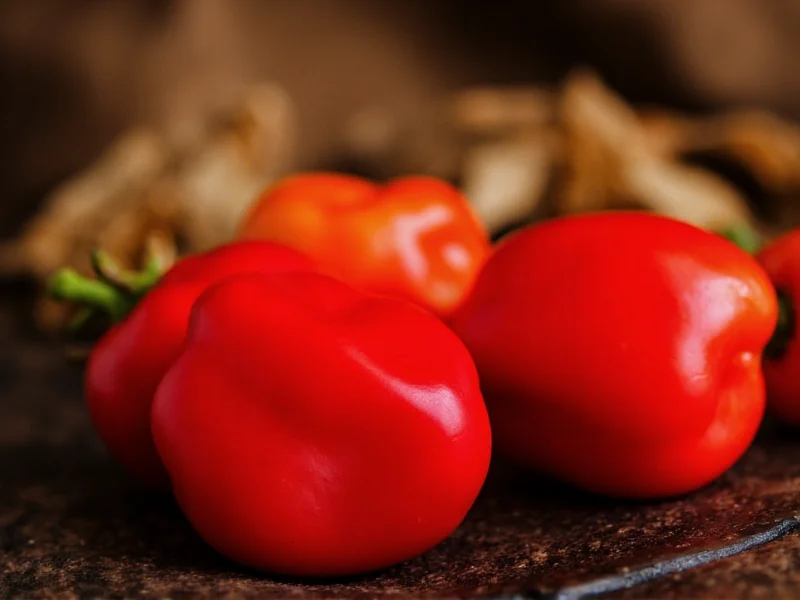Capsicum peppers, commonly known as chili peppers, have fascinated humans for centuries with their varying degrees of heat. Understanding what makes these peppers spicy involves exploring both botanical science and culinary applications. This comprehensive guide explains the mechanisms behind capsicum spiciness, how it's measured, and what factors influence the heat levels you experience.
The Science Behind Capsicum Spiciness
At the heart of capsicum spiciness lies capsaicin, a colorless, odorless compound belonging to the capsaicinoid family. Contrary to popular belief, the seeds themselves don't produce capsaicin—they merely absorb it from the surrounding placental tissue (the white pith inside the pepper). This pith contains specialized glands that manufacture capsaicin as a natural defense mechanism against predators.
When you consume spicy capsicum, capsaicin binds to TRPV1 receptors—heat-sensitive proteins—in your mouth and throat. Your brain interprets this binding as a burning sensation, triggering the release of endorphins that create that familiar 'heat high.' Interestingly, birds lack these specific receptors, which explains why they can eat spicy peppers without discomfort, aiding in seed dispersal.
Measuring Capsicum Heat: The Scoville Scale
In 1912, pharmacist Wilbur Scoville developed the Scoville Organoleptic Test, which measures capsaicin concentration in Scoville Heat Units (SHU). The test originally involved diluting pepper extract until the heat became undetectable to human testers. Modern methods use high-performance liquid chromatography for precise measurement, then convert results to Scoville units.
| Capsicum Variety | Scoville Heat Units | Common Culinary Uses |
|---|---|---|
| Bell Pepper | 0 SHU | Raw in salads, stuffed dishes |
| Jalapeño | 2,500–8,000 SHU | Salsas, nachos, pickled |
| Serrano | 10,000–23,000 SHU | Pico de gallo, hot sauces |
| Habanero | 100,000–350,000 SHU | Caribbean cuisine, hot sauces |
| Ghost Pepper | 855,000–1,041,000 SHU | Extreme hot sauces, challenges |
| Carolina Reaper | 1,400,000–2,200,000 SHU | Specialty hot sauces, novelty items |
Factors Influencing Capsicum Spiciness
Several elements affect how spicy a particular capsicum pepper will be:
- Genetics: Different varieties have evolved distinct capsaicin production levels
- Environmental stress: Drought, temperature fluctuations, and soil conditions can increase capsaicin concentration
- Ripeness: Fully ripe peppers often contain more capsaicin than unripe ones
- Plant position: Peppers growing in direct sunlight typically develop more heat
- Culinary preparation: Cooking methods can concentrate or dissipate heat
Managing Capsicum Spiciness in Cooking
Understanding how to control capsicum spiciness enhances your culinary experience. Removing the white pith and seeds significantly reduces heat while preserving flavor. When handling extremely spicy varieties like ghost peppers, wear gloves to prevent skin irritation. Contrary to popular belief, water doesn't alleviate burning sensations—dairy products containing casein (like milk or yogurt) effectively break down capsaicin molecules.
For those building tolerance to spicy foods, start with milder varieties like poblano peppers (1,000–2,000 SHU) and gradually progress. Pairing spicy capsicum with fats (avocado, cheese) or acids (lime juice) creates balanced flavor profiles that showcase the pepper's complexity beyond mere heat.
Health Considerations of Spicy Capsicum
Research suggests moderate consumption of spicy capsicum offers several potential benefits, including improved metabolism and pain relief through endorphin release. Capsaicin's anti-inflammatory properties show promise in topical pain relief creams. However, excessive consumption can cause gastrointestinal distress in sensitive individuals. The burning sensation typically peaks within 30–60 seconds and gradually subsides over 15–20 minutes as capsaicin metabolizes.
Practical Applications of Spicy Capsicum Varieties
Chefs worldwide utilize different capsicum varieties for specific culinary effects. Thai bird's eye chilies (50,000–100,000 SHU) provide quick, sharp heat ideal for Southeast Asian dishes, while chipotle peppers (2,500–8,000 SHU) offer smoky depth to Mexican cuisine. Understanding these distinctions helps home cooks select appropriate peppers for their recipes without overwhelming the dish.
When substituting peppers in recipes, consider both heat level and flavor profile. A habanero provides fruity notes alongside intense heat, while a cayenne delivers straightforward spiciness. For authentic regional cooking, research traditional pepper usage—many dishes rely on specific capsicum varieties for authentic flavor.
Conclusion
Capsicum spiciness represents a fascinating intersection of plant biology, human physiology, and culinary artistry. By understanding the science behind capsaicin, the measurement of heat through the Scoville scale, and the factors influencing pepper intensity, you can make informed choices about incorporating spicy capsicum into your cooking. Whether you're a heat-seeker or prefer milder flavors, appreciating the complexity behind capsicum spiciness enhances your culinary journey.
Frequently Asked Questions
What part of capsicum is most responsible for spiciness?
The white pith (placenta) surrounding the seeds contains the highest concentration of capsaicin, the compound responsible for spiciness. While many believe seeds are hottest, they merely absorb capsaicin from the adjacent pith tissue.
Why do some people tolerate spicy capsicum better than others?
Genetic variations in TRPV1 receptors affect heat sensitivity. Regular consumption can desensitize these receptors over time, building tolerance. Cultural exposure from childhood also influences perceived spiciness levels.
Does cooking affect capsicum spiciness?
Yes, cooking can both concentrate and dissipate heat. Dry roasting intensifies flavor and heat, while boiling or simmering in liquid can distribute capsaicin throughout the dish. Frying in oil extracts more capsaicin than water-based cooking methods.
Can you reduce the spiciness of capsicum after it's been added to food?
Absolutely. Add dairy products (milk, yogurt, cheese), acidic ingredients (lime juice, vinegar), or sweeteners to counteract heat. Increasing portion size with non-spicy ingredients also dilutes overall spiciness. Never use water, as capsaicin is oil-soluble and won't dissolve in water.
Are there health risks associated with extremely spicy capsicum?
While generally safe, extremely spicy capsicum can cause temporary gastrointestinal distress, nausea, or headaches in sensitive individuals. People with ulcers or IBS should exercise caution. Always handle super-hot peppers with gloves and avoid touching your face during preparation.











 浙公网安备
33010002000092号
浙公网安备
33010002000092号 浙B2-20120091-4
浙B2-20120091-4